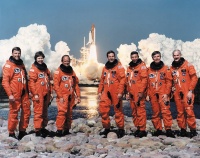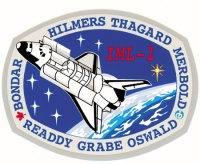STS-42
From The Space Library
 | |
| Organization | NASA-Office of Space Flight (United States) |
|---|---|
| Mission type | Human Crew,Life Science,Microgravity |
| Launch date | January 22, 1992 |
| Launch vehicle | Space Shuttle |
| Launch site | Cape Canaveral, United States |
| COSPAR ID | 1992-002A |
| Inclination | 57 degrees |
| Experiments | Here |
| Alternate Names | 21846 |
| Additional Information | Here |
| Data Collection | Here |
| Payload Mass Up | 13001 kg |
| Payload Mass Down | 13028.64 kg |
| Orbiter | Discovery |
| Lift Off Mass | 2,048,851.82 kg |
| Orbiter Weight at Liftoff | 110,634.09 kg |
| Orbiter Weight at Landing | 99,098.18 kg |
| Landed | Concrete runway 22 at Edwards Air Force Base, Calif. |
| Orbits of Earth | 129 |
| Orbital Altitude | 163 nautical miles (188 statute miles) |
Contents |
[edit] Crew
- Commander: Ronald J. Grabe
- Pilot: Stephen S. Oswald
- Payload Commander:
- Mission Specialist 1: David C. Hilmers
- Mission Specialist 2: Norman E. Thagard
- Mission Specialist 3: William F. Readdy
- Payload Specialist 1: Roberta L. Bondar
- Payload Specialist 2: Ulf D. Merbold
[edit] Mission
Space Shuttle Mission STS-42 was the 45th Shuttle flight and the 15th flight of Discovery. Commanding the mission was Ronald J. Grabe, Col., USAF. Stephen S. Oswald served as his pilot. Mission Specialists included Dr. Norman E. Thagard, M.D.; David C. Hilmers, Lt. Col., USMC; and William F. Readdy. Dr. Roberta L. Bondar, M.D. and Ph.D., of the Canadian Space Agency and Ulf D. Merbold, Ph.D., of the European Space Agency, served as Payload Specialists. The main objective of STS-42 was to carry out the International Microgravity Laboratory-1 (IML-1) mission, a collection of life science and microgravity experiments developed by more than 200 scientists from 16 countries. The IML-1 was the first in a series of IML missions planned to fly aboard the Space Shuttle this decade. In addition the the IML-1 module, STS-42 also carried 12 Get Away Special containers containing experiments ranging from materials processing work to investigations into the development of animal life in weightlessness. Two experiments from the Space Shuttle Student Involvement Program, Convection in Zero Gravity and Zero-G Capillary Rise of Liquid Through Granular Porous Media, were also flown. On Discovery's lower deck, the Investigation into Polymer Membrane Processing investigated advances in filtering technologies in microgravity, and the Radiation Monitoring Equipment-III recorded radiation levels in the crew cabin. The spacecraft maintained a gravity gradient orientation with its nose pointed to space and its tail to Earth in order to minimize firings of the Shuttle's small steering thrusters, thus avoiding disturbances to onboard experiments.
[edit] EVA
[edit] Payload
International Microgravity Laboratory (lML)-1; getaway special (GAS) bridge with 10 getaway specials; IMAX camera; Gelation of Sols: Applied Microgravity Research (GOSAMR)-1; Investigations Into Polymer Membrane Processing (IPMP); Radiation Monitoring Equipment (RME)-lll; Student Experiment 81-09: Convection in Zero Gravity; Student Experiment 83-02: Capillary Rise of Liquid Through Granular Porous Media
[edit] Books about the Space Shuttle Program
Buy This Book Click here |
Buy This Book here |
Buy This Book Click here |
Buy This Book Click here |





